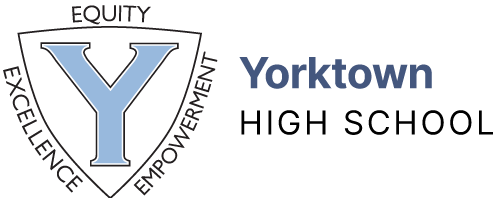Arlington School Board Policy Implementation Procedure (PIP) I-7.2.3.34 says, in part:
The Arlington Public Schools believe that:
- All students are held to high expectations.
- Grades are based on curriculum standards and reflect student demonstrated understanding of course content, growth in the subject area, and course expectations.
- Grades are based on multiple and varied tasks/assessments over time.
- Grading scales are precise, clear, and fair and are communicated to students and parents through course syllabi by the date of the appropriate Back-to-School Night.
In keeping with this philosophy at Yorktown, our teachers are expected to communicate clearly and often the on-going performance indicators in their classrooms. Most of our teachers will make use of the following grading scale while also remembering that student grades reflect student achievement and not student behavior.
APS Grading Scale and Required Statements
APS GRADING SCALE |
|||
Letter Grade |
Percentages |
Quality Points |
AP & IB
|
| A | 89.5, 90, 91, 92, 93, 94, 95, 96, 97, 98, 99, 100 | 4.0 | 5.0 |
| B+ | 86.5, 87, 88, 89.4 | 3.5 | 4.5 |
| B | 79.5,80, 81, 82, 83, 84, 85, 86.4 | 3.0 | 4.0 |
| C+ | 76.5, 77, 78, 79.4 | 2.5 | 3.5 |
| C | 69.5, 70, 71, 72, 73, 74, 75, 76.4 | 2.0 | 3.0 |
| D+ | 66.5, 67, 68, 69.4 | 1.5 | 2.5 |
| D | 59.5, 60, 61, 62, 63, 64, 65, 66.4 | 1.0 | 2.0 |
| E | 0-59.4 | 0.0 | 0.0 |
Some of our teachers make use of standards-based assessments in evaluating their students’ knowledge and performance. While their students will still receive the letter grades listed above, these teachers work to evaluate students in a way that focuses on communicating learning objectives to students and their families.
Standards-Based Assessment (SBA) at a Glance:
- SBA provides feedback to students about their strengths and weaknesses. While students do receive an overall letter grade, the grade book clearly shows how that grade connects to their progress on specific content standards.
- SBA bases grades solely on a student’s demonstrated knowledge and skills. SBA does not utilize completion credit, extra credit, zeros, or late penalties to reward or punish students for behavioral issues like timeliness or homework completion.
- SBA recognizes that not all students will learn at the same pace.. Students have the opportunity to revise assignments and re-attempt assessments.
- SBA shifts conversations about grades to conversations about learning.
- Like traditional grading, some SBA methods vary by teacher and course. These differences are designed to accommodate the particular course requirements, standards, and student needs. The expectations for each course will be clearly communicated by the instructor.
- In evaluating student performance, teachers who make use of SBA will use the following 3-point scale:
| 3.0 | Meeting Expectations | The student meets the expectations for the learning goal completely, independently, and consistently – or to the extent to which it has been taught. |
| 2.0 | Developing | The student shows development toward the learning goal. The student partially meets expectations and/or requires help from peers or the teacher. |
| 1.0 | Insufficient Evidence | The student has not produced sufficient evidence for evaluation of the learning goal. The evidence is missing or incomplete. |
The scores above will translate to the following letter grades:
| Letter Grade | Standards-Based Score |
| A | 2.7 – 3.0 |
| B+ | 2.6 |
| B | 2.4 – 2.5 |
| C+ | 2.3 |
| C | 2.0 – 2.2 |
| D+ | 1.9 |
| D | 1.7 – 1.8 |
| E | 1.0 – 1.6 |
Whether or not a Yorktown teacher makes use of SBA, parents should expect communication regarding student performance through ParentVue, interim reports, report cards, and direct communication from teachers when students are not passing. Most importantly, parents are encouraged to reach out to teachers whenever questions about student progress arise.
 Contact
Contact  Calendars
Calendars Careers
Careers Engage
Engage  District
District
